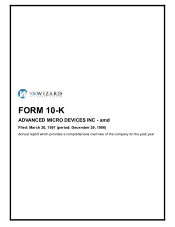AMD 1996 Annual Report Download - page 10
Download and view the complete annual report
Please find page 10 of the 1996 AMD annual report below. You can navigate through the pages in the report by either clicking on the pages listed below, or by using the keyword search tool below to find specific information within the annual report. Embedded processors are also an important segment of the microprocessor
market. Embedded processors are general purpose devices used to carry out a
single application with limited user interface and programmability. A system
designed around an embedded processor cannot usually be programmed by an end
user because the system is preprogrammed to execute a specific task. Key
markets for embedded processors include telecommunications, networking, office
automation, storage, automotive applications and industrial control.
The microprocessor business is characterized by short product life cycles,
intense price competition and rapid advances in product design and process
technology resulting in rapidly occurring product obsolescence. The early
stages of the life cycle of each generation of microprocessors is generally
characterized by high demand, prices and margins. Historically, as the product
life cycle progresses, prices and margins decrease rapidly and production
volume rapidly increases. Toward the end of the product life cycle, as the
life cycles of one or more future generations of microprocessors are
beginning, prices and margins decline further and demand for the product
ultimately ends.
The establishment of hardware and software standards for PCs and the
emergence of numerous PC suppliers have caused the PC industry to be extremely
competitive, with short product life cycles, limited product differentiation
and substantial price competition. To compete more effectively, many PC
suppliers have evolved from fully integrated manufacturers with proprietary
system designs to vendors focused on building brand recognition and
distribution capabilities. Many of these suppliers now rely either on Intel or
on third-party manufacturers for the major subsystems of their PCs, such as
the motherboard, and increasingly are outsourcing the design and manufacture
of complete systems. The third-party suppliers of these subsystems, based
primarily in Asia, are focused on providing PCs and motherboards that
incorporate the latest trends in features and performance at low prices.
Increasingly, these third-party suppliers are also supplying fully configured
PC systems through alternative distribution channels.
BUSINESS GROUPS; PRODUCTS
AMD participates in all three segments of the digital IC market - memory
circuits, logic circuits and microprocessors - through, collectively, its
Communications and Components Group (CCG), its Computation Products Group
(CPG) and its Programmable Logic Division (Vantis).
COMMUNICATIONS AND COMPONENTS GROUP
CCG products ($1,364 million, or 70%, of the Company's 1996 net sales)
include Flash memory devices, EPROM devices, voice and data communications
products, embedded processors, I/O devices and network products.
FLASH MEMORY. Flash memory devices are used in cellular telephones,
networking equipment and other applications which require memory to be non-
volatile and to be rewritten. Their ability to be rewritten electrically
provides greater flexibility and ease of use than EPROMs and other similar
integrated circuits which cannot be rewritten electrically. Communications
companies use Flash memory devices in cellular telephones and related
equipment to enable users to program and reprogram frequently called numbers
and manufacturers to preprogram other information. In networking applications,
Flash memory devices are used in hubs and routers to enable systems to store
programmed and reprogrammed Internet addresses and other routing information.
The market for Flash memory devices has recently experienced rapid growth and
is becoming increasingly competitive as additional manufacturers introduce
competitive products and production capacity in the industry increases. A
substantial portion of the Company's revenues are derived from sales of Flash
memory devices.
EPROMs. EPROMs represent an older generation of erasable programmable read-
only memory technology which is used primarily in the electronic equipment
industry. The devices are used in cellular phones and base stations,
telecommunication switching equipment, automotive applications, personal
computer hard disk drives and BIOS (basic input/output system software encoded
in read-only memory which controls access to
6
Source: ADVANCED MICRO DEVIC, 10-K, March 20, 1997























